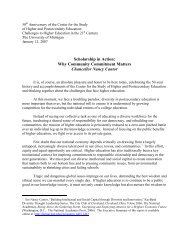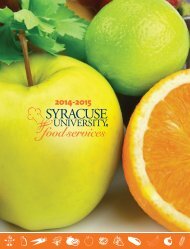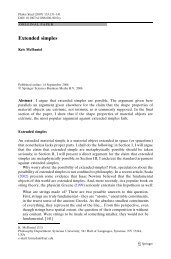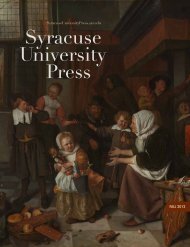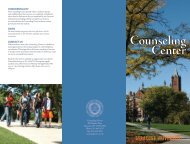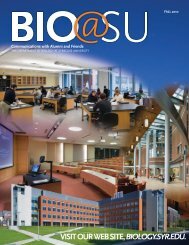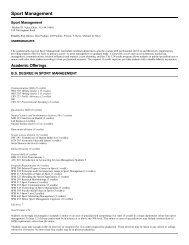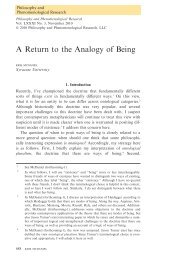Fall 2011 - the Department of Biology - Syracuse University
Fall 2011 - the Department of Biology - Syracuse University
Fall 2011 - the Department of Biology - Syracuse University
- No tags were found...
You also want an ePaper? Increase the reach of your titles
YUMPU automatically turns print PDFs into web optimized ePapers that Google loves.
GRADUATE STUDENT PROFILE:Zaara SarwarGrowing up in Bangladesh, in a traditional societywith conservative values, I have been fortunateto be exposed to a rich diversity <strong>of</strong> experiencesin my academic and social life. This would not havebeen possible without <strong>the</strong> encouragement <strong>of</strong> my familywho treasure education above all else.My mo<strong>the</strong>r, a renowned classicalmusician, exposed my sister and me to<strong>the</strong> rich heritage <strong>of</strong> our culture. My fa<strong>the</strong>r,a scientist and entrepreneur, showed ushow with a sound education we couldcontribute to <strong>the</strong> development <strong>of</strong> oursociety. The achievements <strong>of</strong> my parentshave shown us that we can use oureducation to help Bangladesh, my homecountry, to become a more advanced andglobalized nation. For instance, my sisterwho has obtained a master’s degree inpublic administration intends to promote<strong>the</strong> betterment <strong>of</strong> Bangladesh throughher work in <strong>the</strong> public sector. As formyself, I have always been interested in<strong>the</strong> sciences. My interest in <strong>the</strong> biologicalsciences dates to reading The Double Helixby James Watson. Watson’s description<strong>of</strong> <strong>the</strong> elucidation <strong>of</strong> <strong>the</strong> structure <strong>of</strong> <strong>the</strong>DNA molecule and its elegant simplicityin relation to its role as <strong>the</strong> repository<strong>of</strong> all genetic information stimulatedmy interest in molecular biology. Thisalong with strong high school sciencecourses instilled in me a fascination forbiochemistry and physical chemistrythat facilitate life processes. This ledme to earn a B.Sc. in chemistry andma<strong>the</strong>matics from Queen’s <strong>University</strong>in Canada, following which I decidedto fur<strong>the</strong>r my education by enrolling in<strong>the</strong> structural biology, biochemistry, andbiophysics Ph.D. program at <strong>Syracuse</strong><strong>University</strong>.At <strong>Syracuse</strong> <strong>University</strong> I joined Dr.Anthony Garza’s lab where <strong>the</strong> mainfocus <strong>of</strong> research is <strong>the</strong> mechanisms <strong>of</strong>bacterial bi<strong>of</strong>ilm formation. In nature,and <strong>of</strong> particular interest to medicine, inmany chronic infections bacteria grow assurface-associated communities <strong>of</strong> cellsembedded in an extracellular polymericmatrix. The bacteria in <strong>the</strong> bi<strong>of</strong>ilm <strong>of</strong>tenrespond collectively to environmentalstimuli, sometimes expressing genes orshowing pathogenic activities not evidentwhen <strong>the</strong> cells are growing in isolationor in planktonic culture. In addition,bacteria growing in bi<strong>of</strong>ilms are <strong>of</strong>tenparticularly resistant to host defensemechanisms and conventional <strong>the</strong>rapieswith antibiotics.Recent studies have shown thatbi<strong>of</strong>ilms in <strong>the</strong> environment can actas reservoirs for pathogens such asVibrio cholerae and Shigella spp. betweenepidemics. Bacterial bi<strong>of</strong>ilms thrivein drinking water and food sourcesthat do not undergo proper sanitationprocedures. In fact, poor drinking waterquality is one <strong>of</strong> <strong>the</strong> primary means<strong>of</strong> spreading infectious diseases inBangladesh. Children are especiallysusceptible to infectious diseasescaused by bi<strong>of</strong>ilm formation. Moreover,malnutrition <strong>of</strong> children, which is acommon phenomenon in Bangladesh,makes <strong>the</strong> children even morevulnerable to chronic diseases. I believethat understanding <strong>the</strong> mechanisms<strong>of</strong> bacterial bi<strong>of</strong>ilm formation, howbi<strong>of</strong>ilms are maintained, and how cellscommunicate within <strong>the</strong> bi<strong>of</strong>ilm are veryimportant. These topics are <strong>the</strong> subjects<strong>of</strong> my dissertation research.In our laboratory, we study <strong>the</strong> gramnegativesoil bacterium Myxococcusxanthus. Although not a humanpathogen, M. xanthus grows in bi<strong>of</strong>ilmsin which <strong>the</strong> bacteria act cooperativelyin movement and in subduing anddigesting bacterial prey which are <strong>the</strong>irsource <strong>of</strong> food. In addition, in response toadverse environmental conditions such asnutrient depletion, M. xanthus undergoesa complex life cycle during which bacteriain <strong>the</strong> bi<strong>of</strong>ilm aggregate and formmulticellular structures called fruitingbodies (Figure 1).16 THE DEPARTMENT OF BIOLOGY AT SYRACUSE UNIVERSITYS




